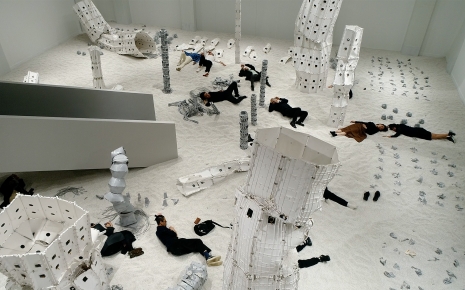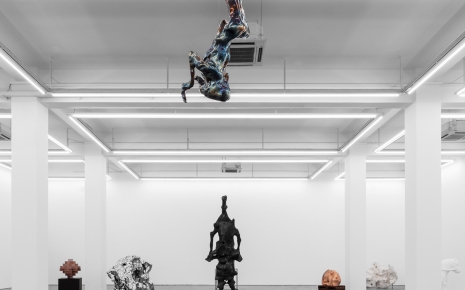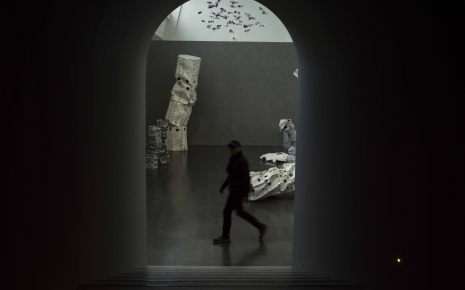Match Openings (Matter as Actor, London)2023-08-31
Match Openings (full elaboration))
Year: 2022
This work contains three parts.
PartⅠSculpture(Particle Series)
Material: Stainless Steel
Method: Rubbing and Cutting
Dimensions:35x50cm approx. / single, variable size when combined Total 6 groups
PartⅡ Drawing (Scrawls of Visions)
Material: Ink on Xuan paper
Dimensions (painting): A 50x50cm B 35x35cm
9 paintings each set, with a nine-square-grid as the basic formation, displayed in tandem with the 6 formation variations of the Particle sculpture.
Part Ⅲ Movable stage-like pedestal
Material: Assembled wood panel
Dimensions: 136x136x20cm (nine pieces)
Land space: 408x408cm
Land space while transforming: 680x680cm
Elaboration:
Formally, this work is an evolution of the previous representative work ‘Artificial Rock’ (Jiashanshi).
The new work Match Openings looks like a game of chess concealed with two opposing camps: one side can be explained as a camp based on the cycle of God's creation of the world in Genesis, with a six-day work cycle suggesting the working cycle we use so far, represented by number combinations formed by particle sculptures: 1, 2, 3, 4, 5, 9. 1 is one particle, 2 is two particles, and so on, with the sixth consisting of nine particles, suggesting the existence of the "nine-square-grid" of the opposing camp, and the seventh day is a day for rest, so no numerical extension is needed.
As the basic unit of a stainless steel sculpture, the Particle takes the "infinite-cut" method of cutting a stone into six parts, then reorganized to a new finite particle, a symbol of the infinity exists within. The idea of "infinite-cut" echoes the paradox of "A one-foot stick, cut in half every day, will not be exhausted in ten thousand years" from Chuangcius, "The World" and the paradoxical story from the ancient Greek philosopher Zeno, "Achilles will never overtake the tortoise" ( first cut something in half, then cut in half of one half, repeatedly, there will always be half left, thus becoming an "infinite-cut"). These two ancient philosophy paradoxes exploring nature, influence the latest physics developments to this day. When the 'infinite-cut' reconstitutes the structure of a particle, as the sculptures show, the concept of 'infinity' is internalized and becomes a finite particle, an amorphous lattice of motion with energy, and particle-to-particle connections allow this infinitive particle structure to grow infinitely again, becoming an invisible sculpture, It is an amalgamation of transcendent and perception, dissociates visual and the abstract.
The other side, the formation is based on the basic principles of Luoshu nine-square-grid game from the ancient Chinese classic Hetu and Luoshu (which features the number '5' in the center, horizontally and vertically, all diagonal sums totaling 15 for absolute balanced order). The nine-square-grid serves as the most fundamental cultural foundation in China till today.
The " Movable stage-like pedestal " contains nine identical square panels, with the nine-square-grid as the basic formation, which variate 6 times during the exhibition, each time confines the metaphor in Genesis: for example, the creation of light on the first day, air on the second, and then: earth and plants, cosmic galaxies, flowers, birds, fish and insects, animals and people. These six variations change the layout of the nine- square- grid, which in return changes the order of the creation cycle made of particles on it.
The paintings of the Scrawls of Visions on the walls looks like a formation guide (described later), simultaneously variate six times. The seventh time refers a rest day, the Genesis formations and the nine- square- grid return to their initial states.
The painting series Scrawls of Visions is the latest attempt to paint (scrawl). It is called "scrawl" rather than painting, because this method is to differentiate all traditional painting methods. The painting regulates itself a “clear strokes” method and the scrawling process was completely improvised. Although traditional brush and ink are used, knowledge related to traditional them is no necessity. A wild free attempt, contemplating the paradoxical relationship between absolute freedom and absolute limitation. Unlike the flat view in which objects in different shapes and distances obscuring each other, unlike the multiple viewpoints in traditional ink painting, this painting employs a overhead view, showing an infinite progression from macro to micro. Here, painting is also an act of experiencing real freedom at the respect for boundaries, accepting the formal pattern and order of big and small, first and last.
The confrontation of two different formations is not just a show- on, more like a game without a winner or a loser. This work here expresses the infinite possibilities of a paradoxical structure of inside and outside, finite and infinite, East and West, freedom and order. The particle sculptures are free to increase in number according to their own equilibrium, and the stainless steel material also reflects the colors and shapes of its surroundings, forming a complex mutual reflection and a dynamic fragmented image, a sensual expression of the uncertain future and the contradiction and confrontation between the natural and artificial cut-ups, which are independent and convergent, but still free to grow in at last. In short, the works express both the paradox of the world and the complexity of the game, as well as a 'Baroque' sense for carefree and motion.
Artistic Proposition
The art of the future should be a synthetic art.
Contemporary works have to synthesize multiple conceptual elements, which means the work cannot be a single presentation of an idea, but a complementary superimposition of a variety of ideas expressing a view on the nature of this age (Science and Humanities). It is not a collage, a juxtaposition or composition, or a combination, or an appropriation, much less an expression of one idea. Synthetic art melts at least three or more interdisciplinary elements, through fusion or superimposition, endows art (sculpture) an organic life in this New/W-media era.
Just like the virtual world has influenced our lives, so the current concept of art juxtaposes the virtual with the fictional, appearing as information, no longer as meaning, Sensuality, rationality, and various contradictions, like science, philosophy, and religion, constantly taking place on new media by means of superimposition and synthesis. At the beginning of the last century, art borrowed the word ' experiment' from science, making art sub-disciplined, refined, and extreme. In the spirit of experimentation, art in the future will again borrow the idea of 'superposition' from the physical sciences, so that it will be a multiple composite medium between man and man, man and the world, man and the nature, rather than a carrier of communication and information, hence a new medium for self-educating, regaining its vitality.
Medium iterates the matter. Message iterates the ideas.
The art in the future should make all contraries resilient and layered.
Above photos© Zhan Wang. Courtesy Lisson Gallery. Photography by George Darrell














